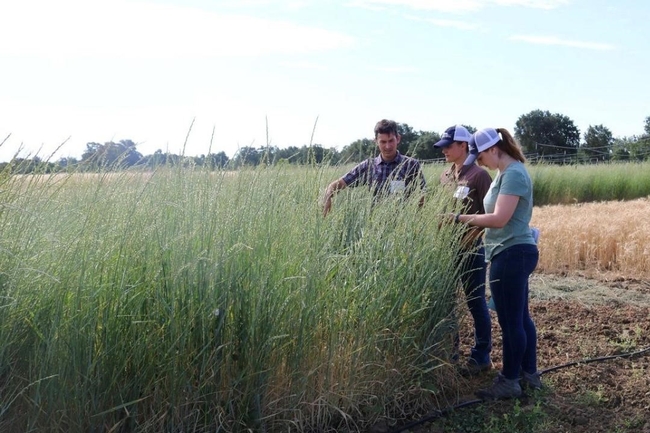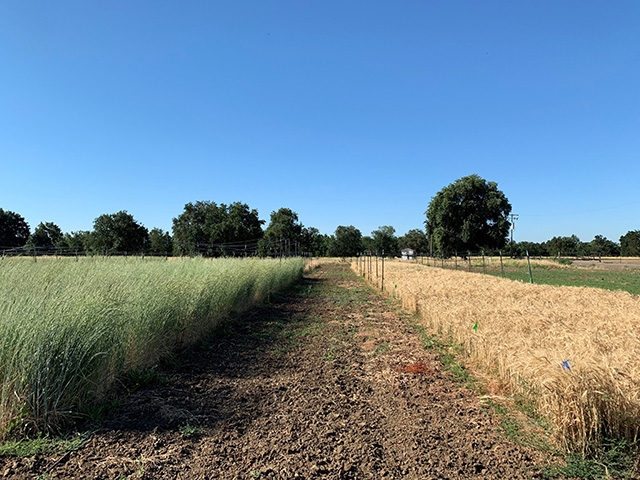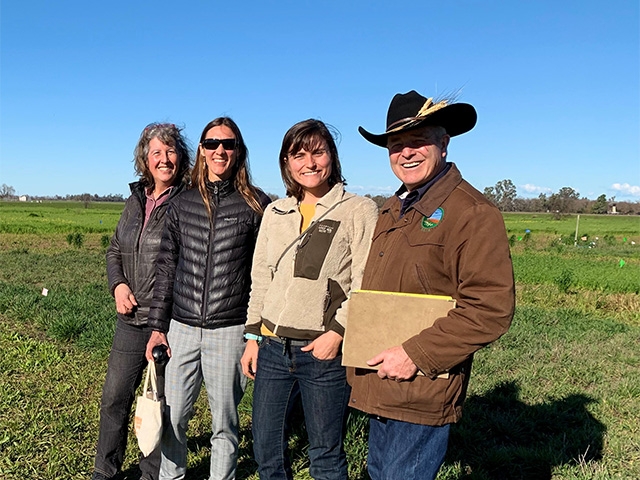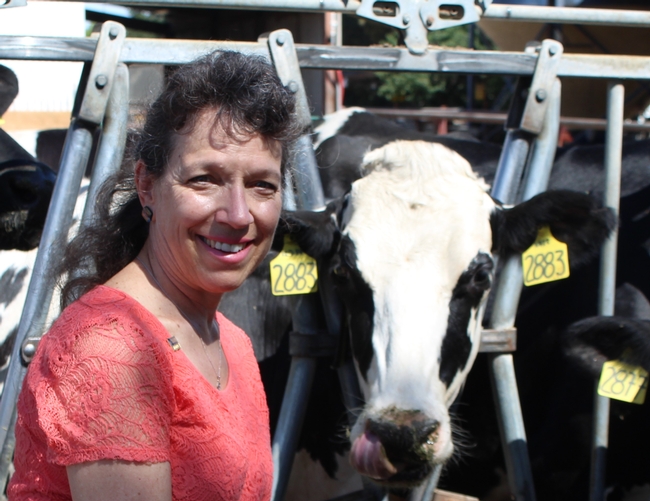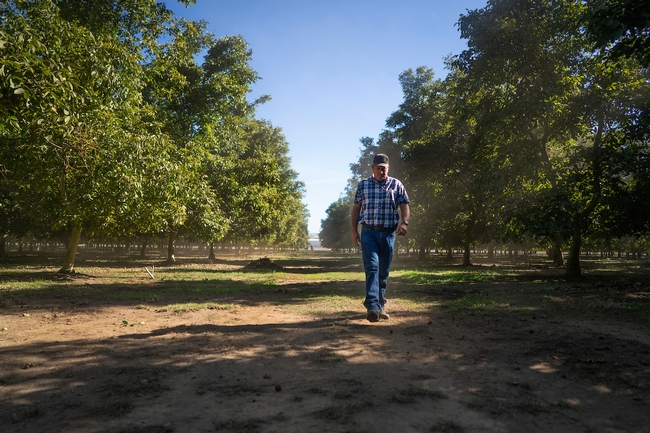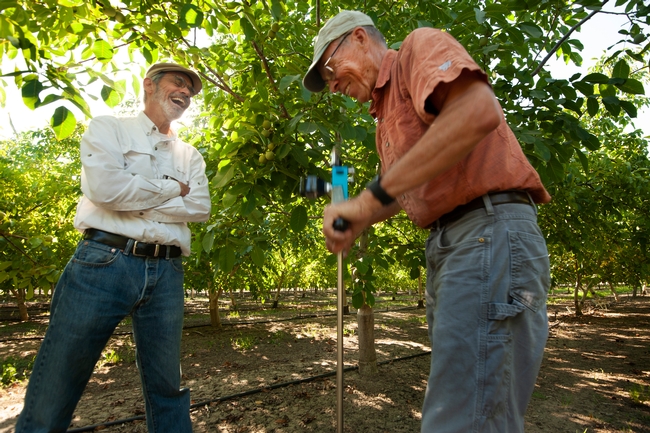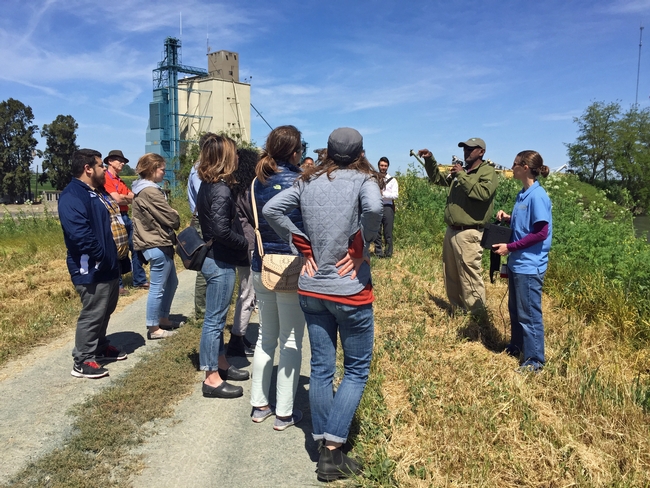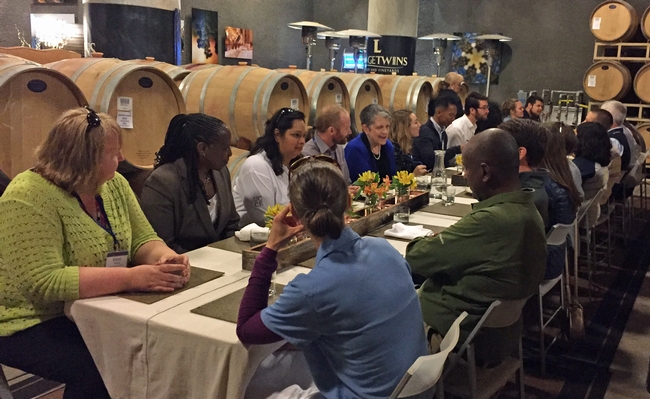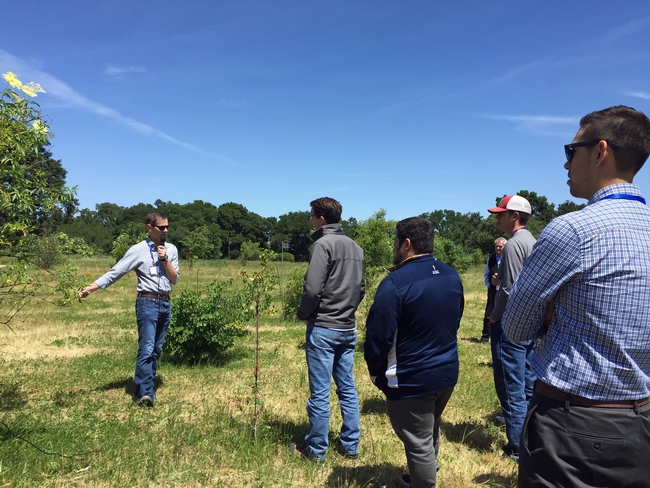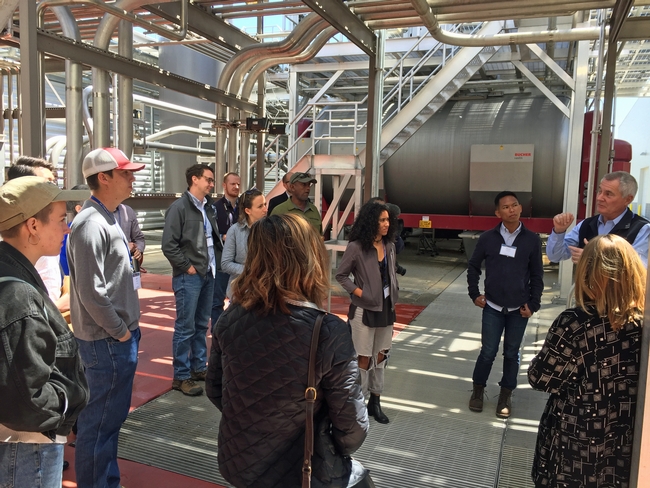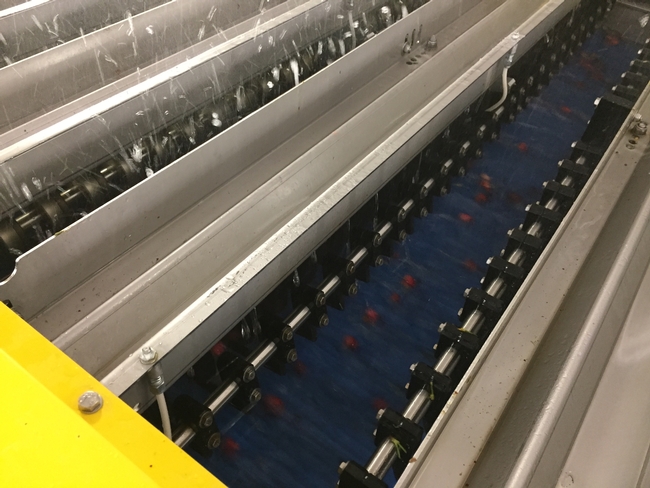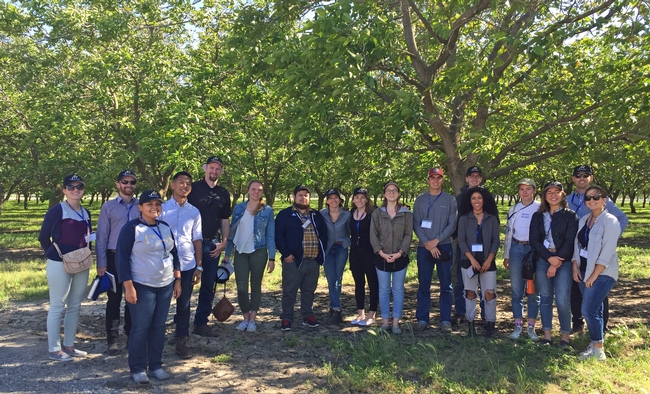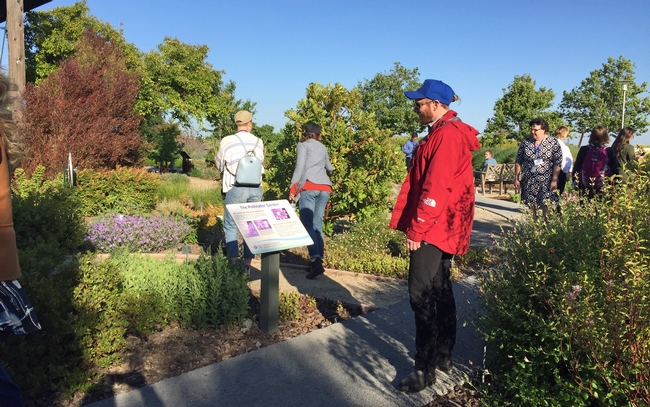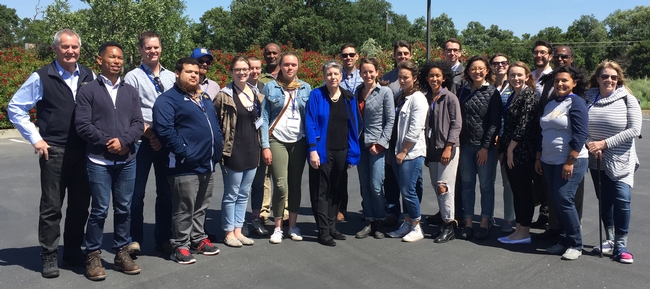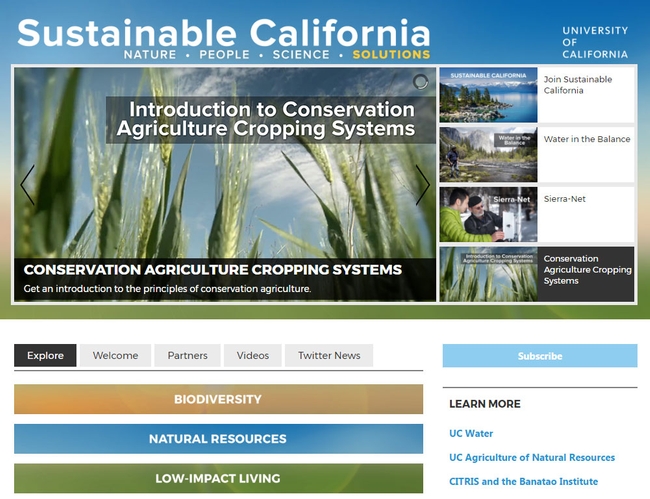Posts Tagged: sustainability
No-till annual wheat better for soil health in California’s climate
One more reason to adopt sustainable cultivation
California wheat farmers could both maintain their yields and improve soil health by growing annual wheat without tilling the soil year after year.
This could be one more encouragement to farmers to adopt a sustainable practice commonly called conservation tillage, no-till or minimum-till cultivation, impacting how we grow a grain that supplies about 20 percent of the calories and protein for people around the world.
A new study, by a team led by Mark Lundy, University of California Cooperative Extension specialist in UC Davis' Department of Plant Sciences, offers new insight for decades-long discussions around soil conservation, sustainable agriculture and climate-warming emissions related to growing our food. The study has been published in the journal Soil and Tillage Research. For the first time, researchers have shown that annual wheat that is not tilled each year is better for stashing carbon in the soil than perennial wheatgrass, while still yielding more crop in Central California.
Previous studies have looked at annual wheat that is tilled each year, annual wheat that is not tilled, and a cousin species, perennial intermediate wheatgrass (trademarked Kernza), which also is not tilled. But until now, no one has looked at all of the benefits and trade-offs together. Most importantly, “no one has ever controlled for tillage,” Lundy said. “And, no one has compared annual wheat to perennial intermediate wheatgrass over multiple years in a Mediterranean climate, which is what we have in California.”
This study also is unique because it delves into the deeper question of what is going on in the soil that drives the different results for carbon there. Soil carbon reflects various processes linked to plant activity and soil health. Measuring the different forms of soil carbon may also signal whether a farming system is accumulating carbon in the soil over time – a plus for reducing climate-warming gases in the atmosphere.
“Measuring soil carbon is complex and nuanced,” said Kalyn Taylor, the lead author on the paper. “We started this experiment because we wanted to know whether and how plant activity and tilling or not tilling would affect the carbon story belowground in California's climate.”
“When we started this study, we thought the crop being perennial or annual would drive the differences in carbon storage in the soil,” Lundy added. Specifically, they had expected perennial wheatgrass would lead to more carbon in the soil because of its deeper, better-established root system. “But that's not what we found,” he went on. “What we found was, it was the lack of tillage, plus the level of productivity of common annual wheat, that made the difference in soil carbon here in California.”
Soil carbon in annual vs. perennial grain
In 2017, Lundy, then-graduate-student Taylor, UC Davis Professor Emeritus Kate Scow and others on the team started measuring different forms of soil carbon in test plots at Russell Ranch, west of campus. Plots were planted with annual wheat that was tilled each spring, annual wheat that was not tilled and perennial intermediate wheatgrass (Kernza) that also was not tilled.
Each year, the researchers measured the carbon present in the soil, the amount of soil organisms (which have carbon in their bodies) and the amount of material the plants created.
At the end of three growing seasons, they found that land planted with no-till, common, annual wheat had the highest amount of soil organisms, measured as biomass, of the three treatments.
The researchers also found soil carbon is more likely to remain stable in the no-till, annual plots, compared to both tilled wheat and wheatgrass.
In addition, the no-till, annual wheat produced plant material more consistently than the perennial wheatgrass across the three years, which saw variation in rainfall.
“Overall, annual wheat grown without soil disturbance or tillage had both higher productivity and higher potential for storing carbon in the topsoil than perennial wheatgrass in our Mediterranean climate,” Lundy said.
Related research
“No-till annual wheat increases plant productivity, soil microbial biomass, and soil carbon stabilization relative to intermediate wheatgrass in a Mediterranean climate,” is online now and will be published in the January 2024 edition of Soil and Tillage Research.
The team also found that tilled annual wheat vs. Kernza stores total carbon at different depths in the soil profile and hosts distinct soil fungal communities, primarily in the root zone and topsoil: Taylor, K., Samaddar, S., Schmidt, R., Lundy, M. and Scow, K., 2023. Soil carbon storage and compositional responses of soil microbial communities under perennial grain IWG vs. annual wheat. Soil Biology and Biochemistry, p.109111.
Previous work comparing the perennial grain known as intermediate wheatgrass (trademarked Kernza) to annual wheat had not distinguished the extent to which soil health benefits are a function of the perennial nature of the crop. Read the story here.
This story was originally published on the UC Davis News site.
Meyer receives Bradford-Rominger Agricultural Sustainability Leadership Award
Deanne Meyer, UC Cooperative Extension livestock waste management specialist, is this year's recipient of the Eric Bradford & Charlie Rominger Agricultural Sustainability Leadership Award, given by the Agricultural Sustainability Institute (ASI) at UC Davis.
Meyer is being honored for her leadership in substantially improving the sustainability of California's dairy industry through her research and outreach.
The Bradford-Rominger award recognizes and honors individuals who exhibit the leadership, work ethic and integrity epitomized by the late Eric Bradford, a livestock geneticist who gave 50 years of service to UC Davis, and the late Charlie Rominger, a fifth-generation Yolo County farmer and land preservationist.
Meyer has directed the environmental stewardship efforts of the California Dairy Quality Assurance Program (CDQAP)—a voluntary partnership between the dairy industry, government and academia—since the program's inception in 1996.
Meyer's dedication to build a bridge between industry and regulatory agencies has paid dividends for California's air and water quality. With Meyer's leadership, more than 700 dairy farms have completed an on-site, third-party evaluation of their facility's manure management. The program has been so successful that it received California's highest environmental honor, the Governor's Environmental and Economic Leadership Award, in 2007.
Reflecting on Meyer's work, Glenda Humiston, UC vice president for agriculture and natural resources, said, “Serving as chair of California's Water Quality Task Force in the mid-1990s, I had a front row seat to the challenges Deanne faced as she organized CDQAP and brought many unlikely allies to the table. The many successes of that program is a testament to her skills as both a scientist and a diplomat.”
Beyond Meyer's work with CDQAP, her research in groundwater salinity has provided farmers, agency staff and other concerned stakeholders with unbiased information presented with an understanding of agricultural realities.
“Her efforts, leadership, and dedication are so valued by all the diverse sectors she works across,” said Anita Oberbauer, professor and dean for Agricultural Sciences at UC Davis. “By working closely with regulatory agencies and farmers, she ensures our state's livestock and dairy producers have the tools that they need to meet the environmental challenges.”
Learn more about the Bradford-Rominger award on the Agricultural Sustainability Institute's website.
Past winners of the Bradford-Rominger award include UC Cooperative Extension advisors Rachael Long, Rachel Surls and David Lewis, Sustainable Conservation's Director of Resources Daniel Mountjoy; UCCE advisor Rose Hayden-Smith, UCCE specialist Ken Tate, UCCE advisor Mary Bianchi, natural resource conservation consultant Kelly Garbach and UC Davis lecturer emeritus Isao Fujimoto.
A nutty idea: A little stress could be good for walnuts
When it comes to watering walnuts, most California growers believe you need to start early to keep trees healthy and productive throughout the long, hot summer. But according to striking results from a long-term experiment in a walnut orchard in Red Bluff, growers can improve crop production if they hold off irrigation until later in the season and directly measure their trees' water needs.
The findings from researchers at the University of California may help farmers optimize water use.
“It's a game-changer,” said walnut grower Hal Crain, who welcomed researchers on to his orchard to test irrigation optimization. “It's clear to me you can improve nut quality and yield by applying water based on what the tree wants and needs, rather than just watering when it's hot outside and the soil is dry. That's a big deal for walnut growers and for the entire agricultural industry.”
Changing the paradigm
Crain is a second-generation farmer whose family has been growing walnuts in Butte and Tehama counties for 55 years. Like most walnut farmers, Crain had always started irrigating in early to mid-May when the days grew warmer and the trees sprouted leaves.
“That's standard practice for probably 90 percent of California's walnut growers,” said Crain, walking amid his trees on a sunny afternoon. “The theory is that when you irrigate early, you preserve the deep moisture in the soil that trees need to survive the heat of summer.”
But that's not how it works, the research shows. Instead, trees that grow in saturated soil early in the season don't develop the deep roots they need to thrive.
“With all the water right there at the surface, the lower roots suffer,” explained Bruce Lampinen, UC Cooperative Extension orchard management specialist with the UC Davis Department of Plant Sciences. “Trees end up with a very shallow root system, which doesn't serve them well as they try to extract moisture from the soil later on.”
Lampinen has long suspected that walnuts were getting too much water in the spring.
“A lot of the symptoms we see like yellowing leaves and various diseases can all be explained by overwatering,” said Lampinen.
So Lampinen did what scientists do: He set up an experiment. Five years ago, with funding from the California Walnut Board and the U.S. Department of Agriculture, he joined forces with Ken Shackel, a plant sciences professor with UC Davis, and Allan Fulton, an irrigation adviser with UC Cooperative Extension. Together, they led a team of scientists testing irrigation on Crain's ranch.
“Hal is an exceptional partner,” Fulton said. “Farmers have a lot to accommodate when they host an experiment like this, with researchers going in and out of the orchard at all hours. He had to work around our people and the timing of our water treatments. He's always eager to experiment with technology and learn new things, and he shares what he learns with other growers. Hal completes the circle.”
Tough nut to crack
When is the best time to irrigate? Researchers say the trees hold the answer. Scientists use pressure chambers, which are air-pressure devices that measure a leaf or small shoot to gauge how hard the plant is working to pull moisture from the soil.
“Just because the soil looks dry doesn't mean the plant is suffering,” said Shackel, who specializes in plant physiology. “Pressure chambers let you ask the tree how it's feeling — sort of like taking a human's blood pressure — which is a much more accurate way to measure a plant's water needs.”
For the last five years, the team has been applying different water treatments to five blocks of trees. One block is getting standard, early irrigation. Crain's orchard managers begin irrigating the other blocks when the trees reach different levels of water stress based on pressure-chamber readings.
The trees that experience moderate stress are doing the best. Their irrigation usually starts in mid-to-late June, several weeks later than when standard watering begins.
“You can tell just by looking at that block that the trees are healthier,” said Crain, standing beneath a canopy of lush, green trees. “And, we're starting to see greater yields and better nut quality.”
Translating the research
The research is helping scientists advise farmers on irrigation.
“My biggest take-away is knowing when to start watering is a really important factor to the health of your trees,” Lampinen says.
Pressure chambers — sometimes called pressure bombs — can cost more than $3,000, and high-tech versions are under development.
“I tell growers a pressure bomb would pay for itself even if you just used it once a year to determine when to start watering,” Lampinen said.
Crain is certainly convinced.
“When you irrigate based on your trees' needs, you optimize water,” Crain says. “I'm not using less water overall, but the water I do use is producing more food. That's good news for everyone.”
This story was originally published in the Fall 2018 issue of Outlook Magazine, the alumni magazine for the UC Davis College of Agricultural and Environmental Sciences.
Delta farm tour gives UC students a broader view of food system
UC Global Food Initiative student fellows from University of California campuses throughout the state gathered for a springtime field trip in the Central Valley to learn more about the relationships between food, farming and the environment.
The day-long tour, hosted by UC Agriculture and Natural Resources, began at a farm that is maintained to support wildlife in the breezy Sacramento-San Joaquin River delta region. The GFI fellows also viewed a habitat restoration project at LangeTwins Winery then watched freshly harvested cherries being processed at Morada Produce's packing plant. They wrapped up the day with a tour of a demonstration garden and a discussion of nutrition education at the UC Cooperative Extension office in Stockton.
UC President Janet Napolitano, who, along with UC's 10 chancellors, launched the Global Food Initiative in 2014, met with the 17 fellows for lunch at LangeTwins Winery.
“We started the Global Food Initiative several years ago with the goal of creating a pathway to a sustainable, nutritious food future for the planet. A small, modest goal,” Napolitano said, adding that she is excited to learn about the fellows' projects.
The GFI fellows are working on projects that range from raising awareness about food production to analyzing the effects of climate change on pollination, and from efforts to make soils safe for growing food in urban areas to using food waste to fuel batteries.
UC Merced senior Ever Serna's GFI project is to educate his fellow college students about where food comes from, before it gets to the grocery store.
“The tour gave me a deeper understanding and appreciation about how food is developed and grown,” he said. “I think when I eat vegetables and fruits, I'm going to be more conscious of what I eat now.”
Reid Johnsen, a third-year Ph.D. student in agricultural and resource economics at UC Berkeley, Global Food Initiative fellow for UC ANR, and participant in the Graduate Students in Extension program, is working with UC Cooperative Extension in Sonoma County to study ranchers' preferences for different payment structures for conservation easement to compensate them for the ecosystem services provided by their land.
“To be able to see agriculture in action makes such a difference to me, to see the way the crops are produced and the variety that's out here,” said Johnsen. “The diversity of crops was not something I was aware of before coming on this trip.”
“I thought it was interesting to see a lot of different agricultural production systems,” said UC Santa Barbara senior and campus GFI ambassador Bryn Daniel, who works with student activists on student food access and housing security issues.
In addition to learning more about food production, the outing gave the fellows an opportunity to network with peers from other campuses.
“That's what I liked about today's meeting, just meeting everybody and getting these fantastic connections,” said Ryan Dowdy, a third-year Ph.D. student at UC Davis who is converting food waste into energy-producing microbial fuel cells.
“I think this program, and especially the fellowship, is really important for young scientists who dive into this really huge subject of global food,” said Claudia Avila, a graduate student at UC Riverside who studies trace metals in urban agricultural soils.
Best kept secret
In welcoming the UC GFI fellows, Glenda Humiston, UC vice president for agriculture and natural resources, said, “I have a feeling a lot of you aren't familiar with our division. As I travel around the state to different campuses, I keep being told that we're the best kept secret, which I personally do not think is a good thing."
She explained that agricultural research has been part of the University of California since the land-grant institution's beginning in 1868 in Oakland. UC ANR has researchers on the Berkeley, Davis and Riverside campuses and UC Cooperative Extension advisors in the county offices, she said, adding, “Here in California, our advisors have very robust research programs.”
Farms are wildlife habitat
Michelle Leinfelder-Miles, UC Cooperative Extension delta crops advisor, introduced Dawit Zeleke, associate director of conservation farms and ranches for The Nature Conservancy, who explained why he farms 9,200 acres of corn, triticale, potatoes, alfalfa and irrigated pasture to enhance foraging habitat for sandhill cranes and other wildlife on Staten Island. The Nature Conservancy partners with UC Cooperative Extension along with the U.S. Fish and Wildlife Service, the U.S. Geological Survey, California Department of Water Resources, Oregon State University, UC Merced and UC Davis to study the relationships between agriculture and natural resources.
The Pacific Flyway for migrating birds passes over the delta. “Eighty percent of waterfowl depend on agriculture for food,” Zeleke said. After wheat harvest, they flood the fields. “You should see it in September, October, November and December. Thousands of birds, ten thousand cranes use this place for habitat.”
Lodi region is zin-ful
En route to lunch, Paul Verdegaal, UC Cooperative Extension viticulture advisor for San Joaquin County, described the Lodi region's wine industry. There are about 750 growers, many of which are small family operations. While 10 to 15 acres used to be typical vineyard size, most have 100 acres to be sustainable and one family member works at an outside job.
“Agriculture is a tough job and there is no guaranteed income,” Verdegaal said.
About 40 percent of the zinfandel in California is grown in the Lodi region, but there are several wine grape varieties planted.
Pointing out the bus window to a vineyard interplanted with a crimson clover cover crop, Verdegaal said, “We do see interest in using as few chemicals as possible and using techniques of the integrated pest management program.”
After eating lunch at LangeTwins Winery in Acampo, the GFI fellows took a tour of the winery with the fourth- and fifth-generation owners, Randy Lange and Aaron Lange. The Langes are founding members of the Lodi Rules Program, which helps growers produce grapes and wines in a manner that is environmentally respectful, socially sensitive and economically sound. They pointed out an array of solar panels covering the grape press room that provide electricity. The Langes are planting native plants around the winery to reduce sedimentation, improve water quality and restore wildlife habitat along the Mokelumne River.
Bing is king of cherries
When the GFI fellows visited at the end of April, sweet cherry harvest had just begun in Bakersfield area orchards, and cherries were being packed and shipped in San Joaquin County.
“Hemmed in by rain to the north and heat to the south, cherry season is only eight to 10 weeks long,” said Joe Grant, emeritus UC Cooperative Extension farm advisor for San Joaquin County.
“While the Bing variety is still the mainstay of the California cherry industry because of its excellent eating and shipping quality,” said Grant, “acreage of other high quality and earlier-maturing varieties has increased in recent years to lengthen the harvest season. But Bing is still king.” Asked about the effects of climate change on cherries, Grant explained that warmer temperatures are reducing the number of winter chilling hours, which cherries need.
The fellows saw the hand-picked fruit being processed for packing at Morada Produce, a family farm in Linden that also grows walnuts, peppers and onions.
“Keeping produce cold is key to maintaining quality,” said Scott Brown, Morada's production manager, as the fellows watched fresh, cold water rain down onto the freshly picked sweet cherries. The leaves and stems floating to the top were removed as the red clusters glided in the water to the cluster cutter, which gently separated the clusters into individual cherries. Gently conveyed through the plant in flowing water, the cherries were sorted by size and quality at the highly mechanized facility. Air ejectors spit out rejected fruit, so only 70 percent makes it into a packed box.
“Fruit picked on Monday is packed Tuesday, then shipped to Korea, Japan, Australia and other export markets to be eaten by Friday,” Brown said.
The fellows were fascinated to see the steps taken to ensure high-quality cherries are cooled, sorted and packaged for shipping to stores and consumers.
“It was just so much more complicated than I knew,” said Jess Gambel, a third-year Ph.D. student at UC San Diego who is studying the effects of climate change on bee pollination in squash plants.
Sustainable gardening
The tour wrapped up at the UC Cooperative Extension office in Stockton, with a discussion about how UC CalFresh and the Expanded Food and Nutrition Education Program help low-income Californians attain adequate nutrition and food security, followed by a tour of the demonstration garden maintained by the UC Master Gardener Program volunteers.
“There are more pollutants in urban runoff than in ag runoff,” said Karrie Reid, UC Cooperative Extension landscape horticulture advisor in San Joaquin County. Reid described how she and the UC Master Gardeners work with home and community gardeners to reduce pesticide and water use, and noted that a Water Use Classification of Landscape Species plant list, based on UC research, is available to help gardeners choose landscape plants.
“As a soil scientist, I really appreciated the recurring emphasis on soils as the foundation for agriculture,” said a fourth-year Ph.D. student at UC Berkeley and GFI fellow with Lawrence Berkeley National Laboratory. “From talking with The Nature Conservancy farm operator about how they were conserving carbon in those soils and doing wetlands management to hearing about special properties of the sandy loam soil in this part of the county, and talking with the Master Gardener folks about soil contamination issues.”
This is the third class of GFI student fellows. The undergraduate and graduate student fellows, representing all 10 UC campuses plus UC Agriculture and Natural Resources and Lawrence Berkeley National Laboratory, have helped further UC's Global Food Initiative efforts to sustainably and nutritiously feed the world's growing population by working on food-related projects and raising awareness of this critical issue.
UCTV launches new portal to sustainability for California
The University of California today launches Sustainable California, a new media-rich web portal to share its efforts to sustain the world's sixth largest economy, a site of unequal natural resources and provider of more than half the nation's fruits, nuts and vegetables. The portal is hosted by University of California Television (UCTV).
Principal project partners are UC Water, UC Agriculture and Natural Resources (UC ANR), CITRIS and the Banatao Institute, the Sierra Nevada Research Institute and UC Merced School of Engineering, among others.
“California has a tremendous diversity of plants, animals, ecosystems and people,” said Glenda Humiston, vice president of UC ANR. “The state also plays an important role in feeding the nation and the world. We are now facing climate change, increasing conversion of agricultural land to urban uses, introductions of invasive diseases and pests, and other threats. UC ANR will share its science-based solutions for California sustainability on this new outlet.”
Sustainable California will broadcast stories of sustainability research and outreach conducted by University of California faculty, scientists and student.
“This is what UCTV is about, connecting Californians to the real-world, inestimable values that the UC provides all of California,” said UCTV Director Lynn Burnstan. “We are very excited to be able to join these partners and give the public direct access to what they are doing for all our benefit.”
As well as a video introduction to the portal, the launch features three fresh videos, spanning natural resources and agriculture. Water in the Balance, from UCWater, is a five-minute journey from Sierra Nevada snowpack through the state's system of dams and reservoirs to groundwater storage. The first in a series of six episodes, Introduction to Conservation Agriculture Cropping Systems, from UC Agriculture and Natural Resources, features California farmers and UC scientists working together to develop sustainable farming practices. Taking technology to the mountains, Sierra-Net highlights the development of innovative cyber-infrastructure to provide real-time monitoring of the state's water resources and forest health. Produced by the Center for Information Technology Research in the Interest of Society (CITRIS) and the Banatao Institute, viewers will gain a deeper understanding of natural resources management and innovation.
The channel's content is appropriate for audiences of all ages and freely accessible to the public online at uctv.tv/sustainable-cal. The integrated video, article and curriculum format of the channel, in addition to its focus on biodiversity, natural resources and low-impact living, provides users both a look at and connection to practical solutions and approaches the UC is developing, making it a valuable resource for professional practitioners, educators, and media outlets.

